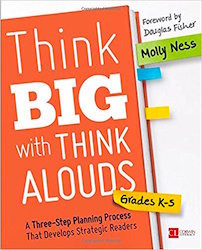Teacher Think Alouds Work in Every Subject
 By Molly Ness
By Molly Ness
In a 6th grade science class, Mr. Rothman reads the following aloud:
Bonds between water molecules have to be broken when they go from ice (solid) to water (liquid) to water vapor (gas) state. Breaking bonds requires energy, so in this process, heat is absorbed from the surroundings. That means these reactions are endothermic in nature.”
Gazing up from his textbook, he asks the class: “Can someone define endothermic for me?” He is met with blank stares and a Ferris Bueller moment of utter silence.
Realizing that his students are lost in the myriad of details and technical vocabulary of this informational text, he approaches the text again.
“This time,” he says, “I’m going to reread this same paragraph while I think aloud. As I think aloud, I’m going to tell you exactly how I’m making sense of this text so that you can understand the comprehension processes that I’m using.”
He begins again, this time periodically stopping to use ‘I’ language to demonstrate how he approaches the text.
✻ At the end of the first sentence, he states, “I’m getting the sense that it’s important to understand that when water changes states, the bonds that connect the molecules are broken.”
✻ He completes the paragraph, and then explains, “I’m now understanding that heat is involved when those bonds are broken. The author is telling me that endothermic means a process where heat is absorbed.”
With this think aloud, Mr. Rothman has modeled the thinking processes that he uses to break down and make sense of complex text. His use of the tried-but-true strategy of a think aloud is a powerful way to engage readers and to impact their learning.
Students who are exposed to think alouds outperform their peers without such instruction on measures of reading comprehension. Think alouds make invisible cognitive processes visible for our students. As we think aloud, we eliminate the guesswork of comprehension.
Think alouds are not just for little kids
Think alouds are not only the purview of elementary school teachers, who may use them in their whole-class storybook read alouds. In fact, think alouds are particularly relevant at the upper elementary and middle school level, where far too many of our nation’s students struggle to read. NAEP data reveals that 69% of fourth graders and 76% of eighth graders reading at or below the basic level, with many of these struggles being related to comprehension.
Research shows the cognitive and academic benefits of thinking aloud: think alouds benefit secondary readers (Coiro, 2011; Lapp et al, 2008) and struggling readers (Migyanka, Policastro, & Lui, 2005; Smith, 2006). While conducting think alouds in a science text with young readers, Ortlieb and Norris (2012) found that students outperformed their peers in the control group on reading comprehension scores.
Furthermore, think alouds engage and motivate students. Ivey and Broadus (2001)’s survey of 1,765 middle schoolers showed that students were motivated by listening to the teacher thinking aloud. When teachers model how they address unfamiliar vocabulary, challenging concepts, and complicated text features, they build their students’ ability to succeed (Lapp et al., 2008).
Use think-alouds across the curriculum
To think aloud across content areas with readers in grade 4 through 8, follow these four tips:
► Align your text with the comprehension strategy that you will model. When thinking aloud, it’s most effective to focus on a few comprehension strategies. Across content area instruction, I find modeling synthesizing, asking questions, and monitoring / clarifying particularly fruitful.
► Plan in advance. Whether Seymour Simon’s Weather or Martin Luther King’s Letter from a Birmingham Jail, every think aloud requires that you peruse the text and use sticky notes to mark the “juicy stopping points” you want to remember. These are the junctures that in one way or another invite you to do something as a reader. Infer, ask a question, lean in and take notice of figurative language, and so on.
Well-executed think alouds do not emerge extemporaneously; they require thoughtful preparation, knowledge of the chosen text, and a meaningful connection between the text and the appropriate comprehension strategies. I like to use sticky notes to mark these points as I preview the text. On these sticky notes, I might go so far as to jot down a quick snapshot of what I will say to my students. Having this script to fall back on makes my think aloud more powerful.
► Provide a visual cue to indicate when you are thinking aloud. As I think aloud, I provide an explicit gesture that helps students differentiate between when I am reading from the text and when I am thinking about the text. To signal for when I’m thinking aloud, I point my index finger to my temple or use a tap on the side of my head. With this gesture, students readily get that the words I’m saying are not found in the book, but rather are in my head.
► Use I-language to jumpstart your think alouds. These “I“ statements – as in, “I wonder if the author means…” and “I’m going to reread…” are the clearest way for teachers to give a model of the reading comprehension strategies that we as proficient readers do. Through “I” language, students begin to see how to apply reading strategies to their independent reading, pursuing their own “I” thinking.
Think alouds are “play by play” accounts
Your goal with think alouds is to provide less savvy readers with a play-by-play of what you – as a skilled reader – think while reading. The secret to success lies in planning think alouds well. They may sound spontaneous, but they are expertly choreographed.
Through “I” language, students begin to see how to apply reading strategies to their independent reading. So grab your nonfiction text, choose your marking spots where you will stop and think, and bring your middle grades readers one step closer to independent use of comprehension strategies.
______________________
 Molly Ness is an associate professor of education at Fordham University’s Graduate School of Education. She graduated Phi Beta Kappa from Johns Hopkins University, and earned her PhD in Reading Education from the University of Virginia. Her research focuses on reading comprehension instruction, the instructional decisions and beliefs of preservice and inservice teachers, and the assessment and diagnosis of struggling readers.
Molly Ness is an associate professor of education at Fordham University’s Graduate School of Education. She graduated Phi Beta Kappa from Johns Hopkins University, and earned her PhD in Reading Education from the University of Virginia. Her research focuses on reading comprehension instruction, the instructional decisions and beliefs of preservice and inservice teachers, and the assessment and diagnosis of struggling readers.
Ness is the author of Think Big with Think Alouds (Corwin, 2018). You can read more about her ideas for grades K-5 at the NCTE Blog. Read a review of Think Big with Think Alouds here at MiddleWeb.



































This makes perfect sense: “Think alouds make invisible cognitive processes visible for our students. As we think aloud, we eliminate the guesswork of comprehension.” Good article.
Good job! I used think-alouds in science. I soon learned that kids were more likely to listen if I talked to myself than if I talked to them.
how will people know about close reading